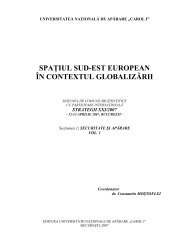PROVOCĂRI LA ADRESA SECURITĂŢII ŞI STRATEGIEI LA ÎNCEPUTUL SECOLULUI XXI
provocări la adresa securităţii şi strategiei la începutul secolului xxi
provocări la adresa securităţii şi strategiei la începutul secolului xxi
Create successful ePaper yourself
Turn your PDF publications into a flip-book with our unique Google optimized e-Paper software.
size-fits-all policy. Different stages of reform and economic development<br />
also means that different rates of progress can be expected from the<br />
neighbouring countries over the coming decade.<br />
The Action Plans would set the objectives for the development of<br />
our relations, short- and medium- term. They would include clear<br />
indications of the prerequisites for each step and of the commitments by<br />
each side. A first group of Action Plans could be agreed in the first half of<br />
2004. The EU assistance programmes to neighbouring countries could then<br />
be adapted to reflect the priorities set out in the Action Plans.<br />
The Union’s neighbourhood policy is distinct from the issue of<br />
possible further enlargement. It concerns countries for which accession is<br />
not on the agenda. The neighbourhood policy does not close the door to the<br />
European aspirations of any country. On the contrary, by enhancing cooperation<br />
and encouraging reform, it should be of great help in supporting<br />
such aspirations, where they exist and are pertinent. On the other hand, it is<br />
clear that the Union’s neighbourhood policy cannot be based on the prospect<br />
of successive accessions of its neighbours.<br />
An important component of the neighbourhood policy is cooperation<br />
at the enlarged Union’s external borders. On the whole, the<br />
Union’s land border with the countries covered by the Wider Europe - New<br />
Neighbourhood initiative will pass from 1300 to 5100 kilometres. Moreover,<br />
the accession to the Union of the two island-states, Cyprus and Malta, will<br />
bring a number of Mediterranean countries closer to the EU territory.<br />
In most of the enlarged Union’s external borders, there is a long<br />
tradition of cross-border contacts and interpenetration. Ethnic and linguistic<br />
kinship, close links based on geography and history are an important part of<br />
life in these areas.<br />
In many places, a vibrant, if not always orderly, transboundary<br />
economic activity has grown over the last years, and contributes<br />
substantially to the budget of households. Politically and economically, but<br />
also from a human dimension, it is important to maintain and manage these<br />
transboundary contacts and to develop new ones. The Union has already<br />
been financing cross-border co-operation on both sides of its borders. A<br />
wide range of activities could be supported: from interconnection of<br />
networks at the micro-scale of border areas, to support of economic cooperation,<br />
contacts between local authorities and NGO’s, and establishment<br />
of border region partnerships [7].<br />
The situations of Russia, the countries of the WNIS and the<br />
Southern Mediterranean are very different judged by most standards. The<br />
course of the 20 th century saw dramatic changes in geography, politics and<br />
culture both on the European continent and in the Mediterranean. These<br />
forces have not necessarily led to greater convergence. Differences are<br />
reflected in the variety and intensity of the Union’s existing relations with<br />
and among the countries of its new neighbourhood [8]. While, for example,<br />
the Union’s relations with Belarus have progressed little since 1996, the<br />
development of EU/Russia dialogue and cooperation on political and<br />
security issues, energy, environment and science and technology over the<br />
past few years has accelerated rapidly.<br />
On the future Eastern external border, regional economic<br />
cooperation among the WNIS is already quite strong, oriented around<br />
traditional flows of trade and investment to and from Russia. However,<br />
encouragement for regional political cooperation and/or economic<br />
integration has not so far formed a strong component of EU policy towards<br />
Russia and the WNIS.<br />
The Northern Dimension currently provides the only regional<br />
framework in which the EU participates with its Eastern partners to address<br />
trans-national and cross-border issues. But participation is restricted to<br />
Russia.<br />
The EU shares an important set of mutual interests with each of its<br />
neighbours. All countries in the new neighbourhood are confronted by the<br />
opportunities and challenges surrounding Proximity, Prosperity and Poverty.<br />
Proximity. In the Partnership and Cooperation Agreements in effect<br />
with Russia, Ukraine and Moldova, the parties also agreed on the need to<br />
establish a strong partnership, based on historic links and common values.<br />
This type of agreement was designed as instruments to help with the<br />
transition process, notably through gradual rapprochement between the EU<br />
and the partner countries and to create a wider area of cooperation. The<br />
geographical proximity increases the importance of a set of issues revolving<br />
around, but not limited to, the management of the new external border and<br />
trans-boundary flows.<br />
Prosperity and Poverty. A new EU approach to its neighbouring<br />
countries cannot be confined to the border regions alone. If the EU is to<br />
work with its neighbourhood to create an area of shared prosperity and<br />
stability, proximity policy must go hand-in-hand with action to tackle the<br />
root causes of the political instability, economic vulnerability, institutional<br />
deficiencies, conflict and poverty and social exclusion [9].<br />
The EU can and should work to spread the benefits of enlargement<br />
for political and economic stability in the neighbouring countries and to help<br />
reduce prosperity gaps where they exist. This should be reflected in a clear<br />
vision for the development of closer and more coherent relations with the<br />
Union’s neighbours over the medium and long term. The EU should act to<br />
305<br />
306





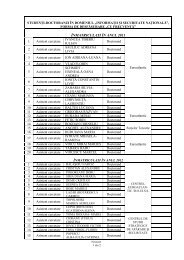
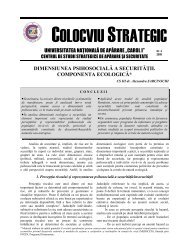
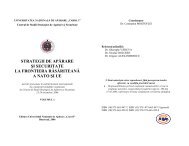
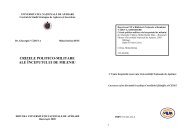
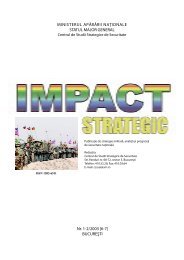


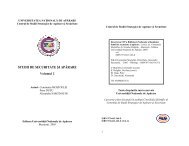



![„CAROL Nr 4 [29]/2008](https://img.yumpu.com/53801719/1/184x260/carol-nr-4-29-2008.jpg?quality=85)
